What is epidermolysis bullosa?
Epidermolysis bullosa (EB) is a group of inherited diseases characterized by blistered skin lesions and mucous membranes These can occur anywhere on the body, but generally appear at friction and minor sites trauma like feet and hands. In some subtypes, blisters may also appear on internal organs, such as the esophagus, stomach, and airways, with no apparent friction.
Epidermolysis bullosa

Epidermolysis bullosa
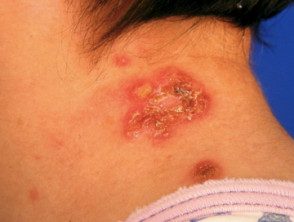
Epidermolysis bullosa
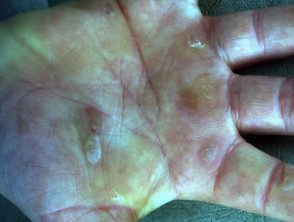
Epidermolysis bullosa

Epidermolysis bullosa
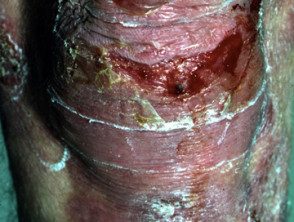
Epidermolysis bullosa

Epidermolysis bullosa
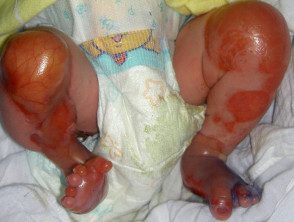
Epidermolysis bullosa
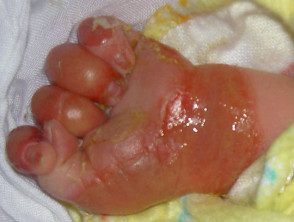
Epidermolysis bullosa

Epidermolysis bullosa
EB should be distinguished from common friction blisters and acquired epidermolysis bullosa (BAD), which is a blister autoimmune disease that is not inherited and often does not develop into adulthood.
EB conditions result from genetic defects of molecules on the skin worried about accession. Loss of adhesion results in blistering. There are four main types of EB based on different blistering sites within the skin structure:
| EB type | The site of blistering within the skin. |
|---|---|
|
Simple epidermolysis bullosa (EBS) |
Epidermis or the top layer of skin cells (keratinocytes) |
|
Binding epidermolysis bullosa (JEB) |
Glossy laminate inside the basement membrane area |
|
Dystrophic epidermolysis bullosa (DEB) |
Dense and superior laminate dermis |
| Kindler syndrome | Mixed pattern or multiple levels within and below the basement membrane area |
Within each of these EB types, there are several subtypes. There are various degrees of severity that vary from mild to severe with each type of EB. The international consensus on the diagnosis and classification of EB has resulted in updated recommendations (2014), based on new clinical tests and molecular data.
Who gets epidermolysis bullosa?
EB is an inherited disease, which means you have inherited one or two EBs genes. In autosomal Dominant EB, only one abnormal gene It is necessary to express the disease. This means that only one parent needs to carry the EB gene. On the other hand, autosomal recessive Inherited EB requires that you have two EB genes (one from each parent) to have the disease. If a person has a recessive EB gene paired with a normal gene, they are called carrier and I don't have the disease.
EB generally occurs at or shortly after birth. Males and females are equally affected. Occasionally, EB may be mild enough at birth not to be apparent, and it is not until the child is older or reaches adulthood before being detected.
What are the clinical features of epidermolysis bullosa?
Simple epidermolysis bullosa (EBS)
For more details, see Simple epidermolysis bullosa.
| EBS subtypes | Characteristics |
|---|---|
|
Located EBS Formerly known as Weber-Cockayne |
|
|
Generalized EBS Formerly known as Koebner |
|
| Generalized severe EBS Formerly known as Dowling Meara |
|
Binding epidermolysis bullosa (JEB)
For more details, see Epidermolysis bullosa junction.
| JEB subtypes | Characteristics |
|---|---|
| Generalized severe JEB Formerly known as Herlitz |
|
| JEB generalized intermediate Formerly known as Non-Herlitz |
|
Dystrophic epidermolysis bullosa (DEB)
For more details, see Dystrophic epidermolysis bullosa.
| DEB subtypes | Characteristics |
|---|---|
| Dominant generalized deb |
|
| DEB severe generalized recessive (R) Formerly known as Hallopeau-Siemens; and; RDEB Generalized Intermediate (formerly Hallopeau-Siemens) |
|
Kindler's syndrome
| Kindler's syndrome | Characteristics |
|---|---|
| Kindler's syndrome |
|
There are many other EB subtypes. The presentation and severity of EB are affected by specific genetic changes and can sometimes be difficult to classify.
Genetic counseling and prenatal Tests are available for EB at some centers and should be considered.
Referral for psychological support should also be considered for children with EB and their family, especially for the more severe subtypes.
How is epidermolysis bullosa diagnosed?
In the dominant subtypes of EB, where an informative family tree is known, it is often acceptable for a specialist dermatologist to make a clinical diagnosis (based on the presenting signs).
Diagnostic tests are also available in some countries and include skin biopsy from a newly induced blister that suffers immunofluorescence antigen mapping (IFM) and electronic transmission microscopy (MS) Mutation analysis (gene blood analysis), although not currently considered the first-line diagnostic test, is also available in some countries.
A referral to a dermatologist will be required.
How is the severity of epidermolysis bullosa evaluated?
EB severity can be assessed using the following scoring systems:
- The Birmingham EB Score
- The EBDASI: EB activity index and scarring
- The iSCOREB: an instrument to qualify clinical results for EB research
- The QOLEB: assessment of quality of life in EB
Treatment of epidermolysis bullosa
general
There is no cure for EB. However, significant research, including gene therapy and cell-based therapy, continues with the goal of improving quality of life.
The most current treatment is symptomatic. the primary The goal is to protect the skin and stop blistering, promote healing, and prevent complications.
Because EB can affect so many different parts of the body, a team of medical specialists is generally required for general care. When necessary, treatment with oral and current Your doctor may prescribe medications to aid healing or prevent complications.
The following are some general measures used in caring for a patient with EB.
- Avoid friction-inducing activities on the skin. This includes infant and toddler management: alternative management techniques are easily learned from a trained healthcare professional.
- Maintain a cool environment and avoid overheating.
- Use foam pads or sheepskins to help reduce friction on furniture like beds, chairs, and baby safety seats.
- Choose clothing (including diapers) and footwear that is lightweight, free of irritating seams or details (eg, zippers and tight elastic).
- Pierce, drain and cover the blisters to promote healing (this should only be done by a person who has received training in wound care)
- Many traditional adhesive tapes and dressings may not be suitable for people with EB, especially those with the more severe forms (eg, RDEB), as their removal can cause additional trauma to the skin. The use of advanced wound care products, such as low-adhesion silicone tapes and dressings, is recommended. However, ingenuity through the use of readily available elements, such as applying additional lubrication (eg, Vaseline / paraffin oil) to some traditional wound dressings, is helpful.
- When EB affects other parts of the body, various care and treatments are adopted. For example, a bland diet when the esophagus is involved or uses stool softeners for constipation, or if the patient has anal blisters.
- Clinical practice guidelines are available on the DEBRA international website *, including those for oral health care, wound care, pain management, Cancer Administration.
- More support and information from both health professionals and those affected by EB:
- DEBRA (Research Association for Dystrophic Epidermolysis Bullosa) International has more than 50 member groups worldwide.
- Eb-Clinet is a clinical network or centers of EB and experts worldwide.

